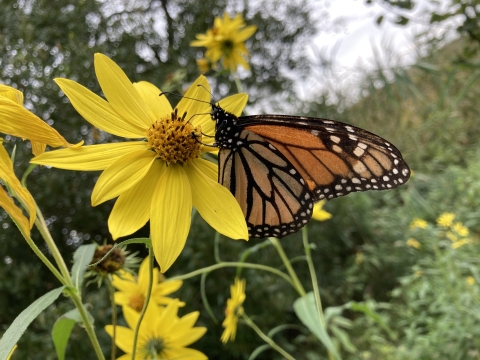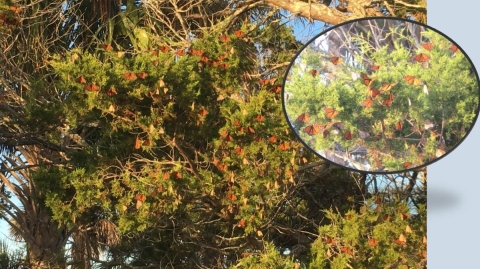States
GeorgiaOn December 12, 2024, the US Fish & Wildlife Service (Service) published a proposal to list the Monarch butterfly (Danaus plexippus) under the Endangered Species Act as threatened. For more information on this proposal, please visit the Service’s Monarch Species Page.
Monarch Butterfly Habitat in Georgia: The monarch butterfly is found in open habitats across Georgia, relying heavily on native milkweed species and nectar-producing plants. This native butterfly visits our fields and gardens throughout the summer and depends on our native floral resources during the spring and fall to help it complete its epic journey to and from its wintering grounds in the mountains of Mexico. Information on the biology of the species and its resource needs can be found in the Species Status Assessment and the Candidate Conservation Agreement with Assurances.
Below is a list of conservation measures that, if incorporated into your land management regimes, can have a profound impact on this imperiled species.
Recommended Conservation Measures:
The Service welcomes conservation measures for this species, including:
[1] Limiting/avoiding insecticide exposure;
[2] Planting (recommended) or seeding of native milkweed and native nectar plants with an aim for diversity of species and bloom timing;
[a] Selecting Georgia-sourced organically-grown native plants;
[b] Maximizing native flowering species across bloom times so that nectar is available throughout the growing season;
[c] Avoiding Common milkweed (Asclepias syriaca) & Tropical milkweed (Asclepias curassavica) which are not native and potentially harmful;
[d] Selecting seed mixes that are free of invasive or non-native aggressive plant species;
[3] Mowing to enhance native floral resource habitat (i.e. mowing only November – March);
[4] Removing trees/brush to promote habitat with native milkweed and native nectar-producing plants;
[5] Targeting hardwood control when thinning woodlands on timber lands and selecting herbicides that preserve the herbaceous layer of plants when doing soil prep;
[6] Promoting habitat with prescribed burning (outside the growing season for native milkweeds; in patches or smaller units is recommended) on a 2-3 year rotation in the Piedmont, 2 year rotation on the coastal plain, and 3-5 year rotation in the mountains;
[7] Managing, creating, or preserving suitable habitat (see links below for additional guidance);
[8] Targeting herbicide treatments (outside the growing season of native milkweeds) to restore suitable habitat; and
[9] Removing and managing invasive species invasive species
An invasive species is any plant or animal that has spread or been introduced into a new area where they are, or could, cause harm to the environment, economy, or human, animal, or plant health. Their unwelcome presence can destroy ecosystems and cost millions of dollars.
Learn more about invasive species .
Beyond land management, other opportunities exist to help this species survive. Here are some other ways to help:
[*] Partner with the Service, states, and other partners to collect and evaluate additional information regarding suitable habitat quality and response to conservation measures or to sustainable forest management activities.
[*] Participate in the International Monarch Monitoring Blitz between July 26 and August 4, 2025.
[*] Participate in Georgia Department of Natural Resources’ Winter Watch Project to help us understand winter monarch behavior in Georgia.
[*] Report Monarch butterfly observations (November – March) on the Journey North website.
[*] Conduct monitoring for suitable habitat using MJV’s Integrated Monarch Monitoring Program
Monarch Butterfly Migration in Georgia: Monarchs migrate across Georgia in the fall on their way to the mountains of Mexico and before returning to Georgia and states to the north in each spring. During fall migration, monarch butterflies may roost in large numbers in evergreen trees on cold nights following a day of strong migration. One such roost, pictured here, was found on the Georgia coast in November 2018.
Links to Resources:
- Connect to Protect Garden Guide: State Botanical Garden of Georgia guidance on creating pollinator gardens.
- Conservation Actions for Electric Power Companies to Support Monarch Butterflies (2019)
- Georgia Pollinator Partnership: Information on, Milkweed, Native Plants, Managing Roadsides for Native Plants and Pollinators, Landscaping, and More.
- Nationwide Candidate Conservation Agreement for Energy and Transportation Lands
- Xerces Society Eastern Monarch Conservation: Creating and managing habitat for pollinators.
- US Department of Transportation’s Roadside Best Management Practices that Benefit Pollinators Handbook
- US Fish & Wildlife Service Websites:
Additional studies on monarch butterflies in Georgia can be found here:
[*] Sonia Altizer, University of Georgia
[*] Ania Majewska, University of Georgia
[*] Jaap de Roode, Emory University











